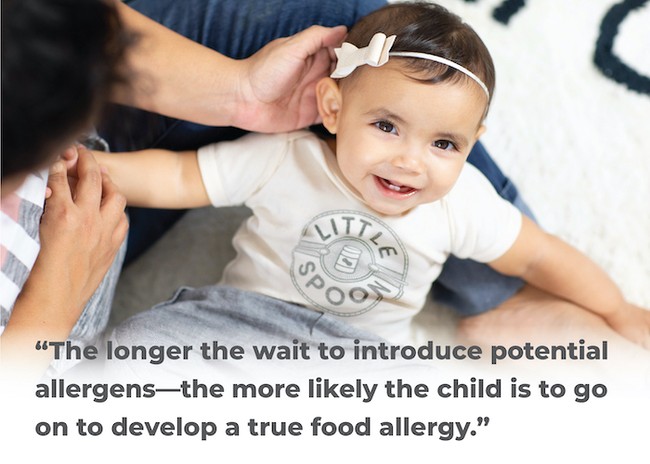By: Sherry Coleman Collins, MS, RDN, LD
The new Dietary Guidelines for Americans (DGAs) were released at the end of December 2021. If you missed the announcement, then you also missed a critical insight for healthcare providers and new parents to help bring an end to a public health challenge simply by being intentional about when and what we feed infants.
Starting as early as six months of age, babies should be fed infant-safe, potentially allergenic foods
The new DGAs reinforce that in order to reduce the risk of food allergies babies should be fed infant-safe potentially allergenic foods once they’ve eaten a few other complementary foods successfully – starting at around 6-months of age but not before 4 months of age. This recommendation is particularly important when it comes to helping prevent peanut allergies.

The inclusion to introduce peanut foods to babies in the new DGAs are the strongest confirmation to date of Addendum Guidelines, first released in 2017 by the National Institute of Allergy and Infectious Disease, which gave hope we could do something to stem the growing tide of food allergies in our country. Research leading to the development of those NIAID guidelines – and since – has consistently demonstrated the power early feeding can have in preventing a lifetime of worry.
New parents already have so many things to think about and that’s why you’re needed
While this step should be a somewhat simple one for new parents to implement, the list of other important items to cover during a well infant visit is already long. That’s why it’s essential that all healthcare providers encourage early introduction to new parents and make it as much of a priority as vaccinations or discussing other developmenal milestones. We have the science that backs early introduction. We have the weight of the DGAs. Now we need to give parents the support they need to feed their babies.

The National Peanut Board launched the Size 4 to 6 campaign in 2019 aimed to educate new parents on the importance of incorporating early introduction into their child’s early development.
Timing is crucial
Ten years ago, you may not have known someone with a food allergy. As rates of food allergies have risen, however, millions of American families have had to change their lives to stay safe from a potential allergic reaction. In fact, I rarely speak with a new parent about beginning solid foods who doesn’t also ask about food allergies.
Although it’s not known exactly why allergy rates have increased, researchers have proven that a simple intervention – such as feeding babies common allergens like peanuts and egg early on – has the power to significantly reduce the risk of developing food allergies. It’s as simple as the phrase “early and often” and this starts in the first year of a baby’s life.
In 2015, the groundbreaking Learning Early About Peanut[i] (LEAP) allergies study showed that babies at high risk (those with severe eczema, existing egg allergy, or both) for developing peanut allergies who began eating peanut foods between 4-11 months had a reduced risk of developing a peanut allergy of up to 86%. The outcome of this rigorous study (which included more than 600 infants and lasted 5 years) was so powerful, that it resulted in changes to the recommendations for infant feeding around the world. As a result, allergy and pediatric professional groups came together to create a consensus document urging the early introduction of peanut foods to these high-risk infants.
Meanwhile, the Enquiring About Tolerance (EAT)[ii] study supported the finding that early introduction benefited all babies, not just those at high risk for developing peanut allergies. And here in the U.S., the National Institute of Allergy and Infectious Diseases (NIAID) released the aforementioned guidelines in 2017 that stratified risk and recommended early introduction as well.
This is too important to ignore and not act
Despite strong media coverage and provider education encouraging early introduction, studies show a number of barriers are keeping more families from taking this important step. The most notable hurdle is limited face time between healthcare providers and new parents to answer their questions and provide the specific guidance parents want. For this reason, it’s even more important that all members of the new parent care team be prepared to discuss and encourage early feeding. Parents want clear, concise, easy to understand advice for feeding their babies potential allergens. Because of the information and many messages parents are getting in those first few months of life – focused on things like sleep (or lack of sleep!) and vaccinations, for instance – it’s important to build these conversations into well-visits. Having these conversations starting around 2-3 months and again at subsequent visits can help avoid missing the window for introduction.

Clinicians and new parents can find guidance and resources to support early introduction at PreventPeanutAllergies.org.
Anyone who works with new parents knows that they can be fraught with concerns. Sometimes these are well-founded and overcoming them can be easy. Yet, other times their concerns have been inflated by misinformation whether through parenting websites, social media filled with scary anecdotes or invalid sources.
This can lead parents with no known risk for having babies with food allergies to become fearful and preoccupied with infant feeding. In other cases, fussy or colicky babies can make parents second-guess when to start feeding baby solids. Whatever the reasons, it is essential that healthcare providers be ready to give parents specific advice and encouragement to begin feeding solid foods by 6 months of age and to introduce common allergens – depending on the baby’s specific history, of course.

To help communicate this important information to parents and caregivers, below are five key points to keep in mind:
- Food allergies affects approximately 5% of children, which means that most children will not develop food allergies.[iii]
- However, research shows that waiting until after 12 months to introduce peanut increases the likelihood of developing a peanut allergy.[iv]
- Always introduce potential allergens to a healthy baby early in the day, and when parents can keep an eye on him or her for at least two hours. Start with just a small amount of infant-safe food – such as peanut butter thinned with a little warm water, breastmilk or formula – and wait 10 minutes. If there’s no reaction, continue to feed until the baby has eaten the full portion or is no longer interested in eating.[v]
- Infants are at low risk for severe reactions when peanut foods are introduced in infancy, according to the experts.[vi]
- Once a peanut has been safely introduced, it should be kept in the diet regularly.[vii]

The question of whether to screen infants for potential sensitivity before feeding potential allergens has also slowed adoption and divided some in our community. As allergists and others who use the available screening tools to help diagnose food allergies will tell you, a great deal of misunderstanding exists about the limits of what each test actually reveals.
It’s helpful to know that a joint group from the United States and Canada published new practice parameters last fall saying screening is unnecessary. As long as an infant has not shown a reaction to a food previously, parents should move forward with introducing it fully into their baby’s diet.[viii] Whether to conduct blood or skin tests for food allergies is a clinical judgement and should be determined based on the patient’s specific situation and evidence-based practices.
The power of prevention is in your hands
Parents and healthcare providers alike can find great information and resources at PreventPeanutAllergies.org. This is a hub of information that includes how-to videos, webinars, handouts, recipes, links and other resources. Since 2001, to date, we have invested more than $38 million in food allergy research and education, which has led to national guidelines to help prevent peanut allergy and the first FDA-approved treatments for food allergies.
Clinicians should keep in mind that early introduction of potential allergens is a best practice when it comes to prevention at this point, much like making recommendations about baby sleeping on his or her back to prevent SIDS. When we think about the number of babies born each year, this simple advice, when acted upon, has the potential to prevent a lifetime of anxiety, increased healthcare burden, and all of the other issues that go along with managing a food allergy. The power of prevention is in our hands – get comfortable with the new recommendations, encourage parents to act on them, and help reduce food allergies in future generations.
References
[i] Du Toit, George, et al. “Randomized trial of peanut consumption in infants at risk for peanut allergy.” New England Journal of Medicine, vol. 372, no. 9, 26 Feb. 2015, pp. 803–813, https://doi.org/10.1056/nejmoa1414850.
[ii] Perkin, Michael R., et al. “Randomized trial of introduction of allergenic foods in breast-fed infants.” New England Journal of Medicine, vol. 374, no. 18, 5 May 2016, pp. 1733–1743, https://doi.org/10.1056/nejmoa1514210.6/NEJMoa1514210.
[iii] “Food Allergy.” National Institute of Allergy and Infectious Diseases, U.S. Department of Health and Human Services, www.niaid.nih.gov/diseases-conditions/food-allergy. Accessed 8 Feb. 2024.
[iv]Simons, Elinor, et al. “Timing of introduction, sensitization, and allergy to highly allergenic foods at age 3 years in a general-population Canadian cohort.” The Journal of Allergy and Clinical Immunology: In Practice, vol. 8, no. 1, Jan. 2020, https://doi.org/10.1016/j.jaip.2019.09.039.
[v] Appendix D Instructions for Home Feeding of Peanut Protein for Infants at Low Risk of an Allergic Reaction to Peanut, National Institute of Allergy and Infectious Diseases, www.niaid.nih.gov/sites/default/files/addendum_guidelines_peanut_appx_d.pdf. Accessed 8 Feb. 2024.
[vi] Increasing Awareness of the Low Risk of Severe Reaction at Infant Peanut Introduction: Implications During COVID-19 and BeyondAbrams, Elissa M. et al. The Journal of Allergy and Clinical Immunology: In Practice, Volume 8, Issue 10, 3259 - 3260. https://www.jaci-inpractice.org/article/S2213-2198(20)30876-X/fulltext.
[vii] Addendum Guidelines for the Prevention of Peanut Allergy in the United States, National Institute of Allergy and Infectious Diseases, www.niaid.nih.gov/sites/default/files/addendum-peanut-allergy-prevention-guidelines.pdf. Accessed 8 Feb. 2024.
[viii] Peanut allergy diagnosis: A 2020 practice parameter update, systematic review, and GRADE analysisGreenhawt, Matthew et al.Journal of Allergy and Clinical Immunology, Volume 146, Issue 6, 1302 - 1334. https://www.jacionline.org/article/S0091-6749(20)31137-4/fulltext.
